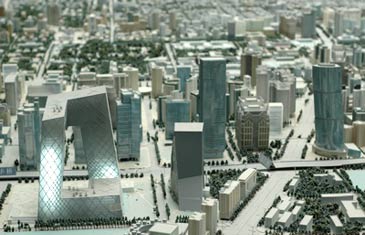
September 13, 2006
Small Worlds

Model of Beijing, photograph by Tom Vanderbilt, 2006
One of the first things I like to do upon visiting a new city is to visit the scale-model version of itself.
From Havana to Copenhagen, I’ve hunted down these miniature metropolises in dusty historical museums and under-visited exhibition halls. I’ve pressed the buttons that light up landmarks and crouched down to peer into tiny streets. Since these models have typically been built decades earlier, they sit as three-dimensional monuments of a city interrupted, captured in time and modeling foam. This can lead to unexpectedly poignant moments, such as the extant World Trade Center towers at the Panorama of New York City at the often-overlooked Queens Museum.
At other times, they are used to assemble a vision of a city not yet here, as I recently discovered on a trip to Beijing. There, at the gleaming new Beijing Planning Exhibition Hall, just off Tiananmen Square, exists what is, in its size and replicating rigor, one of the most impressive urban miniatures I have ever seen.

Model of Beijing, photograph by Tom Vanderbilt, 2006
Occupying an entire room, the miniature Beijing is a staggering testament to the city’s sprawling density, with its broad boulevards, endless housing blocks and imperial sweep. If the model itself seems massive, the sheer size of the expanding city is further evident in the fact that beyond the red ropes encircling the model, the rest of Beijing, that creeping progression marked in the ever outwardly radiating ring roads. This great sprawl, which undoubtedly would have even taxed the effort of a cadre of Chinese modelers, is not rendered as model but as glass plates (upon which one can walk) featuring aerial survey photographs. To top it all off, the second floor has a series of mounted binoculars through one which one can peer down, like some Jules Vernian aeronaut exploring the city from a novel perspective.
As I scanned for one of my few Beijing landmarks, my hotel in Chaoyang district, I suddenly became aware of my own unmediated sense of mirth and wonder, and thought: What accounts for the peculiar appeal of the scale-model miniature?
Surely one reason for their ineluctable allure is that simple Olympian sense of being able to consume as large as entity as Beijing or New York in a single eyeful.
This is a fiction, of course, albeit a powerful one. But the Beijing I was looking at was only as real as one’s imagination would allow it to be. For its painstaking physical verisimilitude, it is an empty, mute, frozen city, vacant of life and urban reality. Nowhere is there Beijing’s cacophonous traffic, nowhere the legendary smog (by some accounts currently the world’s worst). This model does not capture the convulsive destruction of the city’s historic hutong neighborhoods, or the slow eradication of the “Kingdom of Bicycles,” or the droves of immigrants living in temporary work camps who have come to build this next city. There are no construction cranes in this model — this is not real-time, unlike the model in Paul Auster’s novel The Music of Chance, a “City of the World,” marked by “extravagant smallness,” in which past and present commingled (its creator depicted himself as a young man and an adult, in different locations). This model was to be so precise, in fact, it would feature a telescoping model within the model — if its creator had time to build it.

Model of Beijing, photograph by Tom Vanderbilt, 2006
What it does show, strikingly, is the Beijing that will soon become the backdrop for the 2008 Olympics broadcast. And so there was a small representation of Rem Koolhaas’ serpentine headquarters for the Central Chinese Television (with the eerily apt initials CCTV), Herzog and De Mueron’s “Bird’s Nest” Olympic Stadium, and the “Water Cube,” the Arup, et al., National Swimming Center. These are all striking, aspirational architecture, and I could not help but remember back to a cluttered shop in Shanghai that was selling old propaganda posters — the drive for maximum harvests and industrial output and the like — and think that I was not looking at some version of the same, with important buildings by “name” architects standing in for factory quotas and wheat production numbers.
This too seems to be a factor in the appeal of models, i.e., the sense that once you build something, even if it is at 1 to 100 scale, it is essentially completed. Call it anticipatory urbanism. One thinks of the many iconic historical photographs of architects and civic leaders hovering over some new project — the latest being Mssrs. Libeskind, Pataki, etc. pointing down into the new skyline of Lower Manhattan — dominating the city through their Brobdignagian mass, almost willing it into being. Of course, these buildings can now be rendered in a much more thoroughgoing and complex way digitally — pixilated walkthroughs and the like — but those, no matter how well done, still seem a bit otherworldly, like expensive fantasy real estate in some precinct of Second Life. All those gigabytes cannot seem to ultimately hold a candle to some good old-fashioned Lucite and three-dimensions.
There is a pristine, uncorrupted sense to models. They are an ideal of perfection yet to be encumbered by realism, by political demands and the other contingencies of full-scale life. The architectural photographer Balthazar Korab once told me that he taken pictures of a client’s model and the actual completed building, and that the client preferred his photographs of the model.
And one should of course not dismiss the sheer sense of child-like wonder that models possess. As children, we are enchanted by miniature toys not only because we can relate to them in size, but because of the sense they give of being in control of one’s environment — entire armies or dollhouses under one’s domain. As adults, miniatures seem almost nostalgic, for they reconnect us with that small world, and I think something in this feeling explains the strangely powerful appeal of “tilt-focus photography,” which distorts images selectively so that they fool us into thinking we are in fact looking at a miniature. This is, tactically, the opposite of what Korab had achieved — to make the fake look real — but in spirit they are part of the same project.
Raymond Lester, who designed and built the New York City diorama for the 1964 World’s Fair, was an enthusiastic model-railroader as a child before going on to a career that began with making miniature, scientifically precise replicas of battleships during World War II — then eventually progressing to being the chief model-maker for Robert Moses‘ outsized ambitions (including the doomed Lower Manhattan Expressway). But one suspects that somewhere always lurking within this adult in a world of power and ambition was a child with an HO-scale view of the world.

Detail of Mississippi River Basin Model, photograph by Tom Vanderbilt, 2004
There is the question of whether something is too simply too large, too complex to be modeled. Several years ago, I spent an afternoon exploring the incredible ruins of the Mississippi River Basin Model, near Jackson, Mississippi. Built by German POW labor during the war, it is a scale-model replica, spanning some 200 acres, of the river’s entire reach, from northern Mississippi to New Orleans, untold thousands of acres faithfully carved in modeling clay. The Corps used it for several decades to predict the effects of its various engineering projects and, on several occasions, to estimate in real-time the downriver effects during various floods. When the Corps began shifting to computer modeling in the 1980s, the model was vacated, left to slowly decay in the Mississippi humidity and sun. At the Corps’ Waterways Experimentation Station in Vicksburg, however, there are still physical models being built, sprawling lakes and miniature rivers contained in metal hangers.
Some of the engineers still swore by physical models for being able to predict dynamics that even the most powerful computer might miss. But any model is ultimately haunted by a simple, powerful fact: It is not reality. The truth may be that reality is impossible to capture. Something like the Mississippi River is changing every minute, and it was this difficulty in rendering some version of truth that one engineer told me kept him “awake at night.” A few years later, Hurricane Katrina proved his fears correct, even if not as predicted. Nature cannot be adequately replicated in a bathtub, or even a swimming pool.

Mississippi River Basin Model, Google Earth, 2006
What had recently reminded me of the Mississippi River Basin Model was a session of Google Earth. As with a model, Google Earth gives one a God’s eye view of some landscape otherwise unknown in its totality; it also reawakens one’s perspective of the familiar. As it happened, I came upon a stretch of the Mississippi River, and the view I had via my browser reminded me of striding tall atop the topographical model. On an impulse, I punched up Clinton, Mississippi, and watched as the browser “flew” south. After a few minutes, navigating along what I could remember of the place, I was able to find the Basin Model, looking a bit like, well, a drained river. I now had a view, taken from outer space, of a miniaturized landscape, upon which another, even more miniature, landscape was superimposed. To complete the picture, I remembered that at the Corps headquarters was a smaller, table-sized model of the model. As the narrator in Music of Chance had marveled, “a model of the model of the model. It could go on forever.”
Observed
View all
Observed
By Tom Vanderbilt
Recent Posts
A quieter place: Sound designer Eddie Gandelman on composing a future that allows us to hear ourselves think It’s Not Easy Bein’ Green: ‘Wicked’ spells for struggle and solidarity Making Space: Jon M. Chu on Designing Your Own Path Runway modeler: Airport architect Sameedha Mahajan on sending ever-more people skyward



